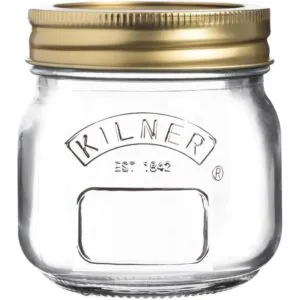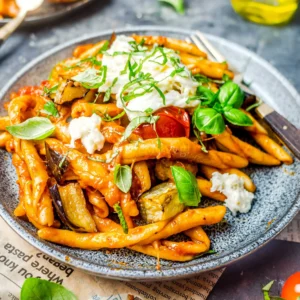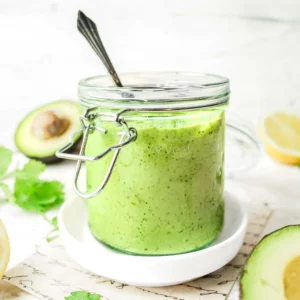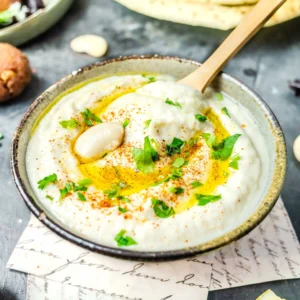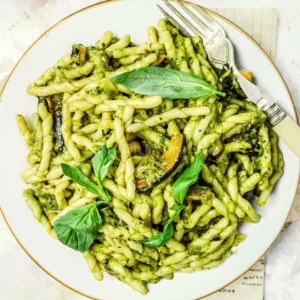Pesto di Basilico (Basil Pesto)
If you’ve only ever had jarred basil pesto, just wait until you try homemade pesto di basilico — it’s revelatory. Fresh, fragrant, and wildly versatile, pesto is a timeless sauce that’s a real treat to eat.
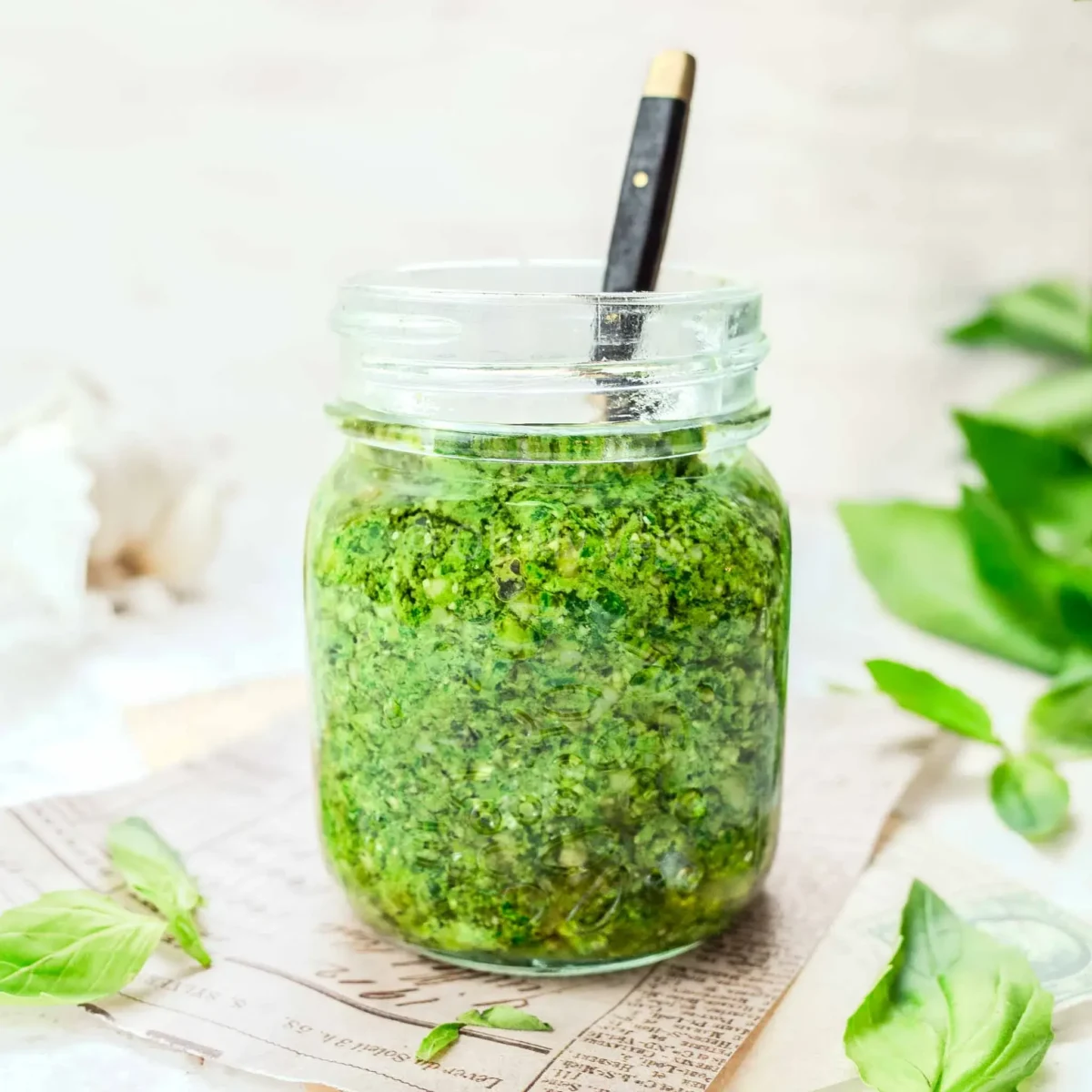
It never ceases to amaze me how terrible store-bought pesto tastes compared to the bright, ambrosial, flavours of the real-deal homemade stuff.
It’s no wonder why. Sneak a peak at the ingredients list of store-bought pesto and you’ll likely find sunflower oil, or the even more erogenous palm oil (not olive oil!) at the top of the list. You’ll find cashews instead of pine nuts. All to cut costs — and boy, can you taste it.
In contrast, homemade pesto di basilico is vibrant green, with a perfect harmony of flavours, and a texture that rests between creamy and herbaceous, light and rich.
My recipe uses only the highest quality of ingredients. And it still manages to be cheaper than buying a sub-par product from a store.
But I don’t need to sell you on the virtues of homemade pesto … I just need to teach you how to make it!
❓What is Pesto di Basilico
Pesto di basilico is one of the foundation sauces of Italian cuisine.
It’s also called Genoese pesto (pesto alla Genovese), pesto al basilico, or simply “basil pesto” in English.
There are many varieties of pesto, but this is the most beloved recipe.
Pesto di basilico is made by pounding fresh basil, garlic, pine nuts, olive oil, and cheese together until it forms a thick, unctuous sauce. It’s then used as a dip, spread, or pasta sauce.
💚Why You’ll Love This Pesto di Basilico
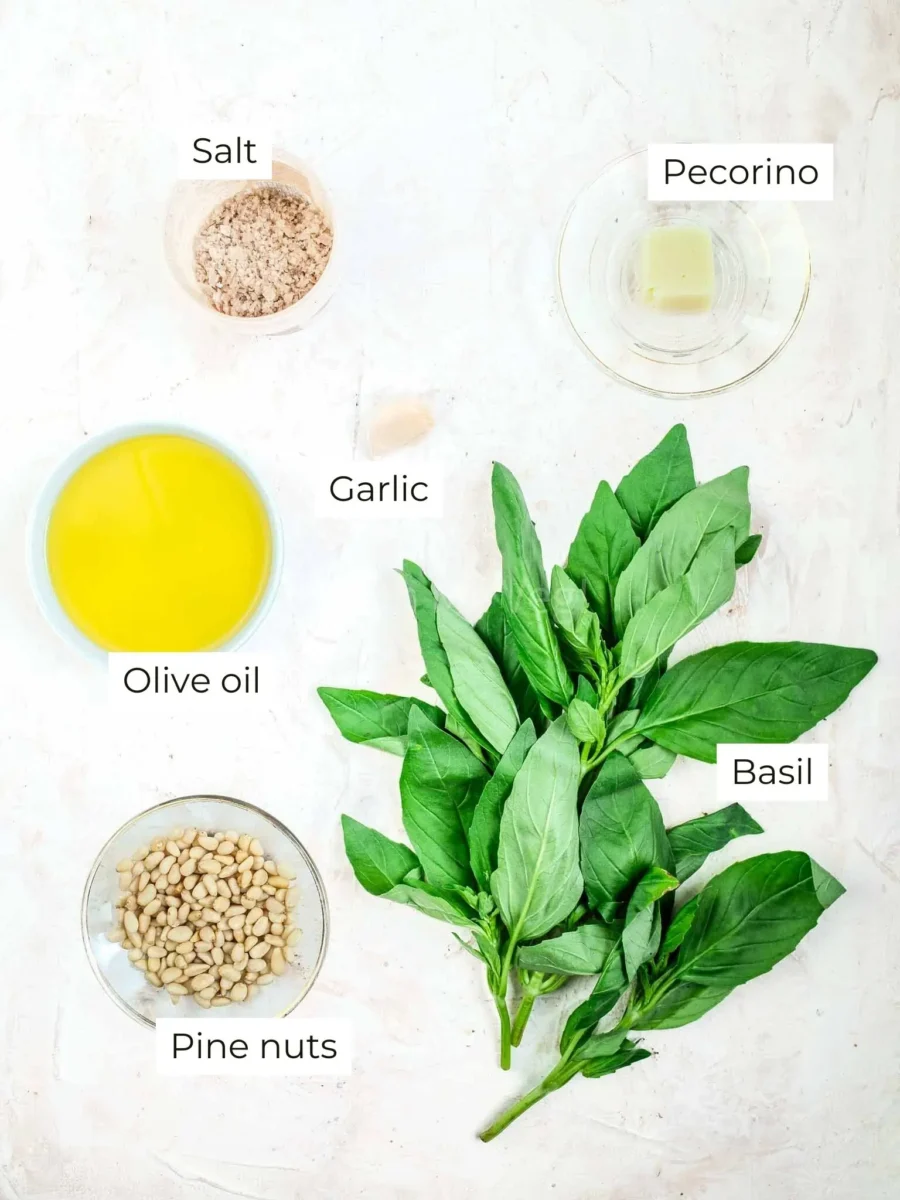
🌿What are the Ingredients in Pesto di Basilico
Pesto uses just a few key ingredients widely available at grocery stores.
Each element is equally responsible for doing heavy flavour lifting. There’s no slackers here! Let’s delve in:
- Basil: Did you know that there are many different varieties of basil? For Italian dishes (including pesto), the choice selection is Genovese basil, which has beautifully shiny dark-green leaves and a robust, peppery flavour. It can be hard to find, so sweet basil is a brilliant substitute (it’s what I’ve used in my photos!). Young leaves are best!
- Pine nuts: Rich, buttery, creamy, and sweet: these little nuts add both flavour and texture. They are expensive, so read the section below for substitutions.
- Olive oil: A great quality, cold-pressed extra virgin oil is crucial to a fantastic pesto. Use an Italian brand for authenticity.
- Garlic: Just a small clove brings a lot of characteristic punchiness to pesto.
- Pecorino: I go into more detail below, but although there are a few different varieties of this cheese, you’ll want a vegetarian variety of pecorino, which is often just called generic “pecorino.” It’s salty, flaky, and smoky, and full-bodied.
- Salt: Pecorino is already quite salty, so we’ll go easy here. I use smoked salt flakes for extra oomph!
Useful Switches, Substitutions, and Variations
No pine nuts? Pine nuts are one of the most expensive nuts. Is it worth it for a jar of authentically scrumptious basil pesto? For me, yes. But if you want to switch them out for a cheaper nut, try almonds (a community favourite), walnuts, or cashews.
Need a nut free alternative? Sunflower seed pesto is for you!
I often make pesto without cheese. It lacks an umami punch, but still tastes delicious — and it’s the most economic way to make pesto al basilico vegan and dairy free. Still want the cheesy flavour, without the dairy? Try nutritional yeast for that cheesy, intensely savoury hit, or choose your favourite plant-based hard cheese.
Lots of readers also love to add a squeeze of lemon juice to bring out the bright, fresh flavours of the herbs and add citrusy undernotes.
➨ Is Basil Pesto Vegetarian?
Typically, basil pesto isn’t vegetarian. That’s because most pesto contains parmesan, which is made using animal rennet (animal’s stomachs). If you buy pesto from a store it’s always wise to check the ingredients, and avoid eating pesto in restaurants. Many people aren’t aware that certain cheeses aren’t vegetarian.
However, homemade pesto is a fantastic way to make the condiment vegetarian-friendly without sacrificing on flavour. Thus, my genovese pesto recipe is vegetarian (as are all the recipes on Oh My Veg!)
If you want to use cheese, as in this recipe, look for non-DOP (designated order of protection) products. DOP cheese is made the traditional way, which nearly always utilises animal rennet.
For example, I’ve used vegetarian pecorino. Pecorino Romano or pecorino Fiore Sardo are both DOP, so avoid those! The same also applies for parmesan: avoid parmigiano reggiano (DOP), and seek out vegetarian-labelled parmesan instead.
If preferred, you can always skip the cheese entirely, as mentioned above.
🧑🍳How to Make Pesto di Basilico (Step-by-Step Photos)
Making Genovese pesto is a much-debated topic.
Should you use a mortar and pestle (the old-fashioned, traditional way)? The faster, modern method of a blender or food processor? How about meeting in the middle by using a chopping board and chef’s knife?
There are certainly benefits to using a mortar and pestle. Bruising basil (by crushing it) extracts a markedly distinct flavour compared to cutting it (as a blender or knife does). Is it superior? Italian grandmas will likely say yes. But, this method takes around thirty minutes. It’s a commitment.
I’ve made this pesto di basilico with all three methods. One came out trumps: using a food processor is far more convenient, saves time (highly efficient!), and there’s no noticeable flavour degradation. For the modern home cook, there’s no doubt about it — I recommend making pesto in a food processor (a blender also works, but not quite as well).
So, while this recipe works perfectly in a mortar and pestle, my step-by-step photos follow the food processor method.

One: Add garlic cloves and pine nuts to a food processor.
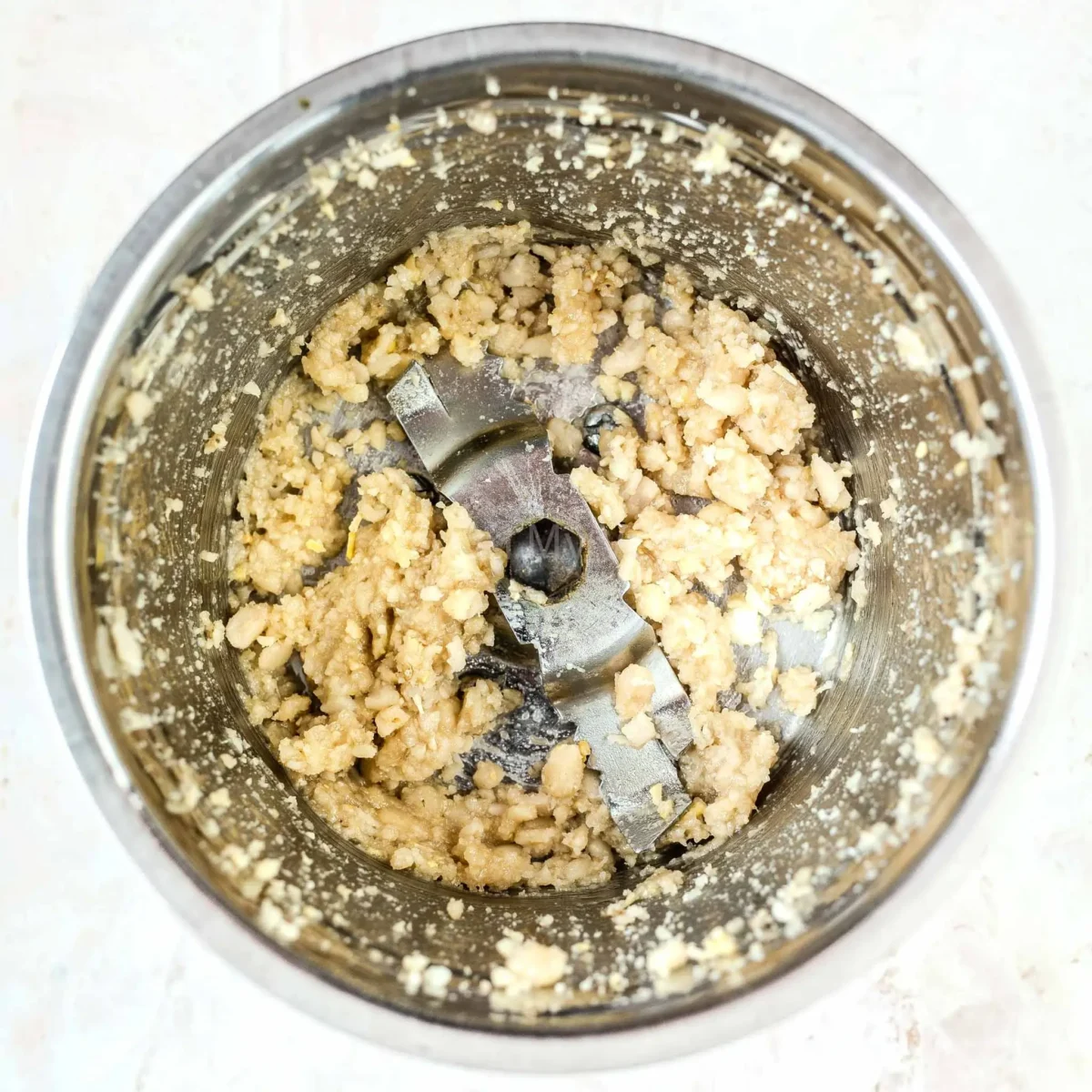
Two: Pulse the food processor to turn the nuts into rough-chopped mixture.
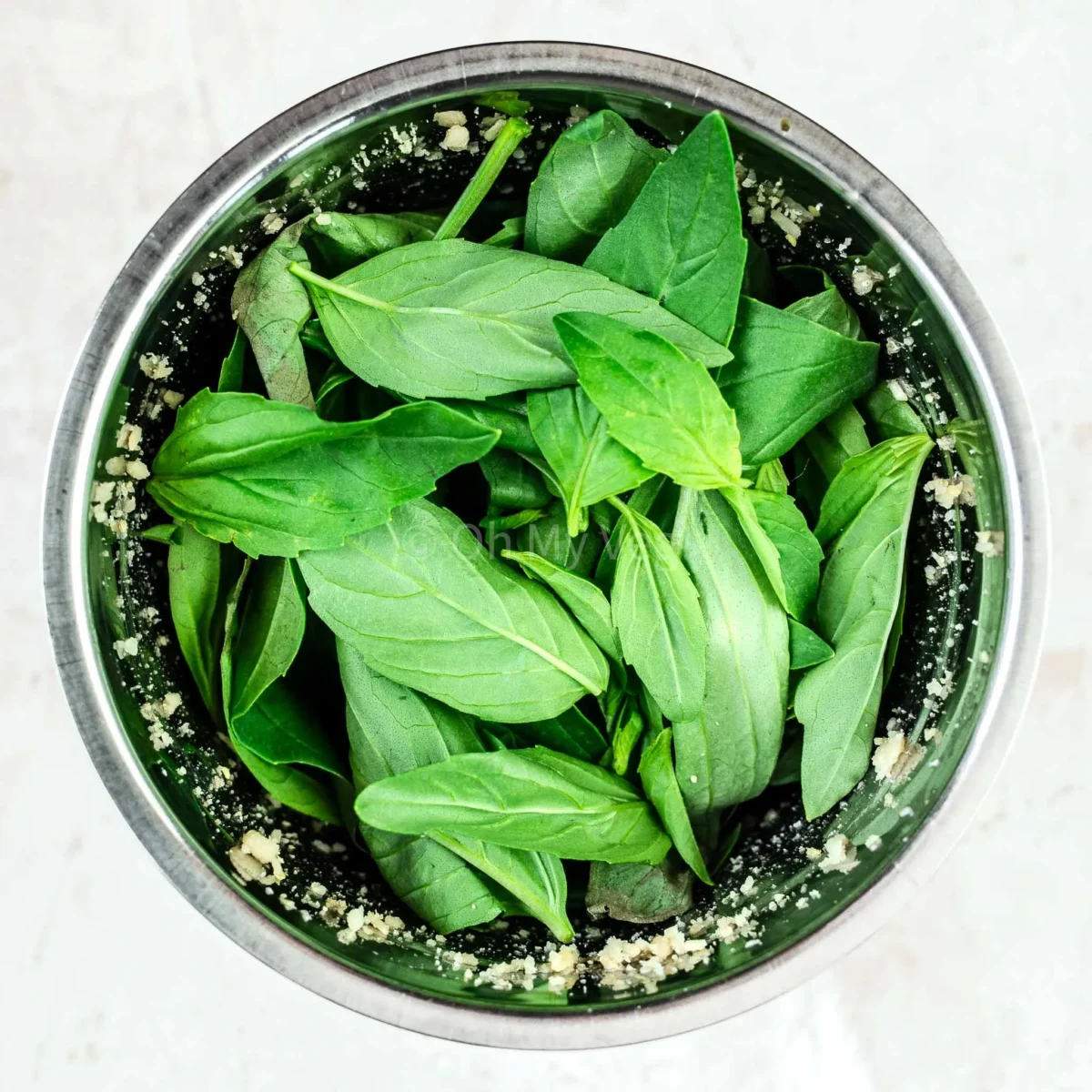
Three: Add basil leaves to the food processor.
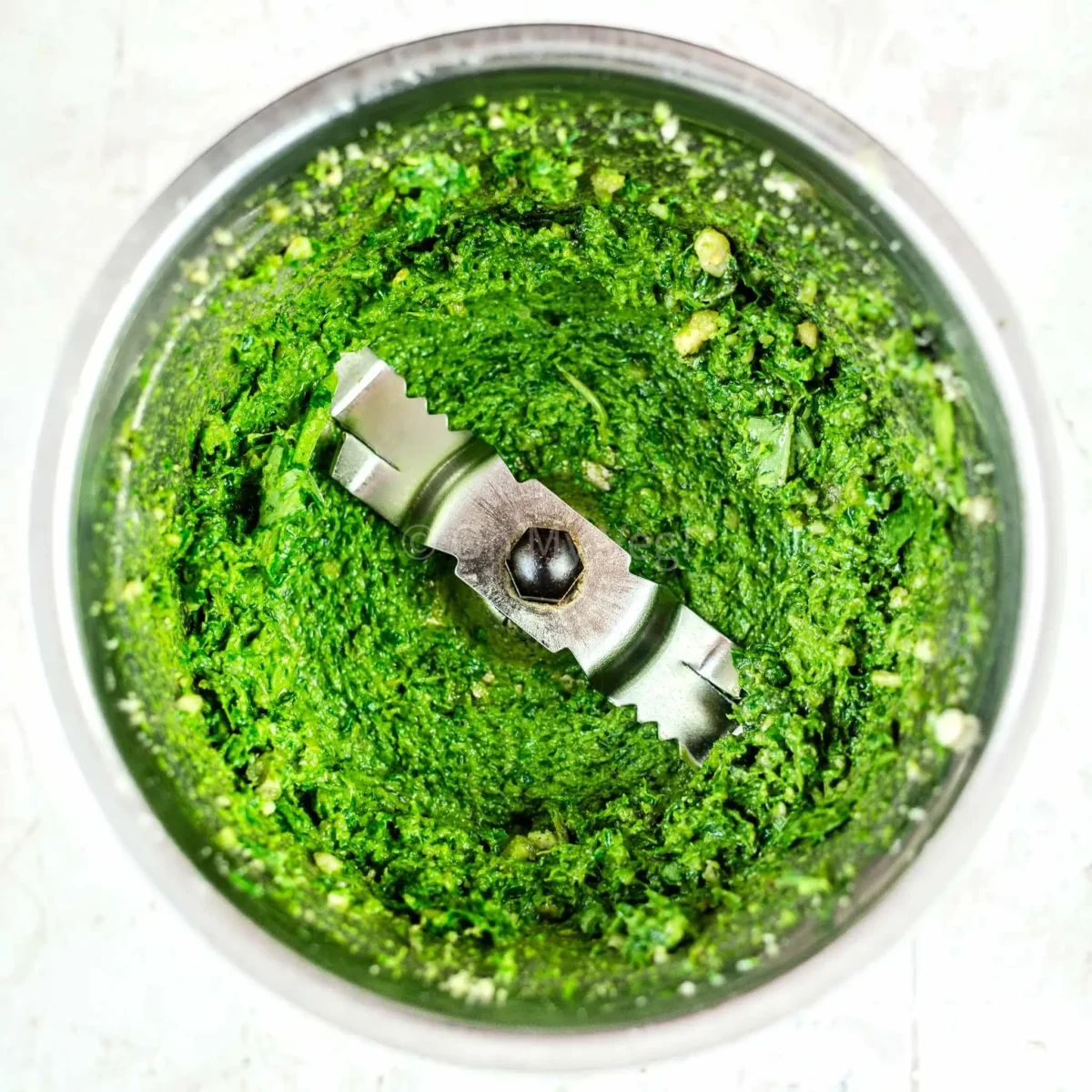
Four: Pulse again, so the basil is very finely chopped.
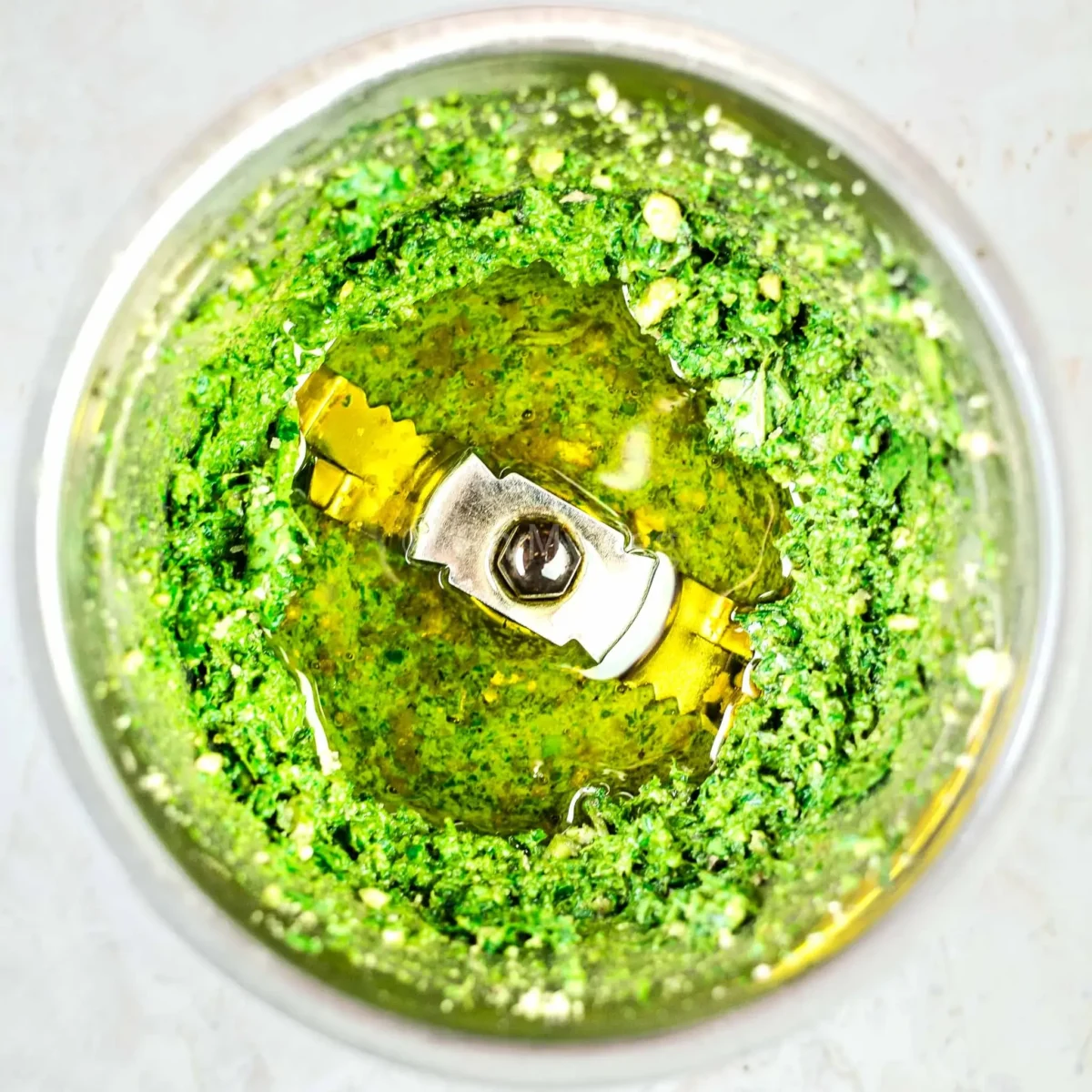
Five: Add olive oil and salt to the food processor.
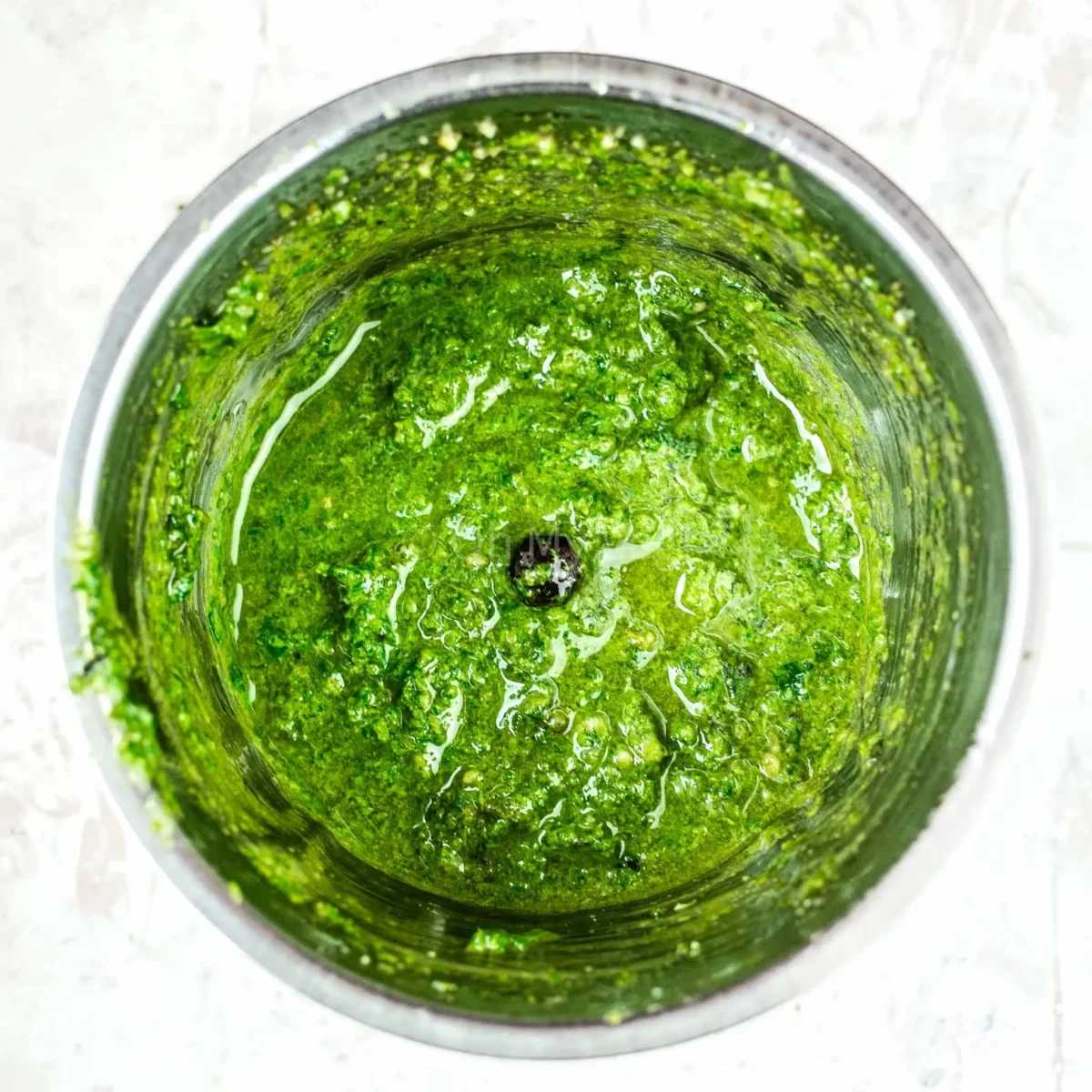
Six: Pulse just once, briefly, so the pesto comes together. You can also just stir the oil through.
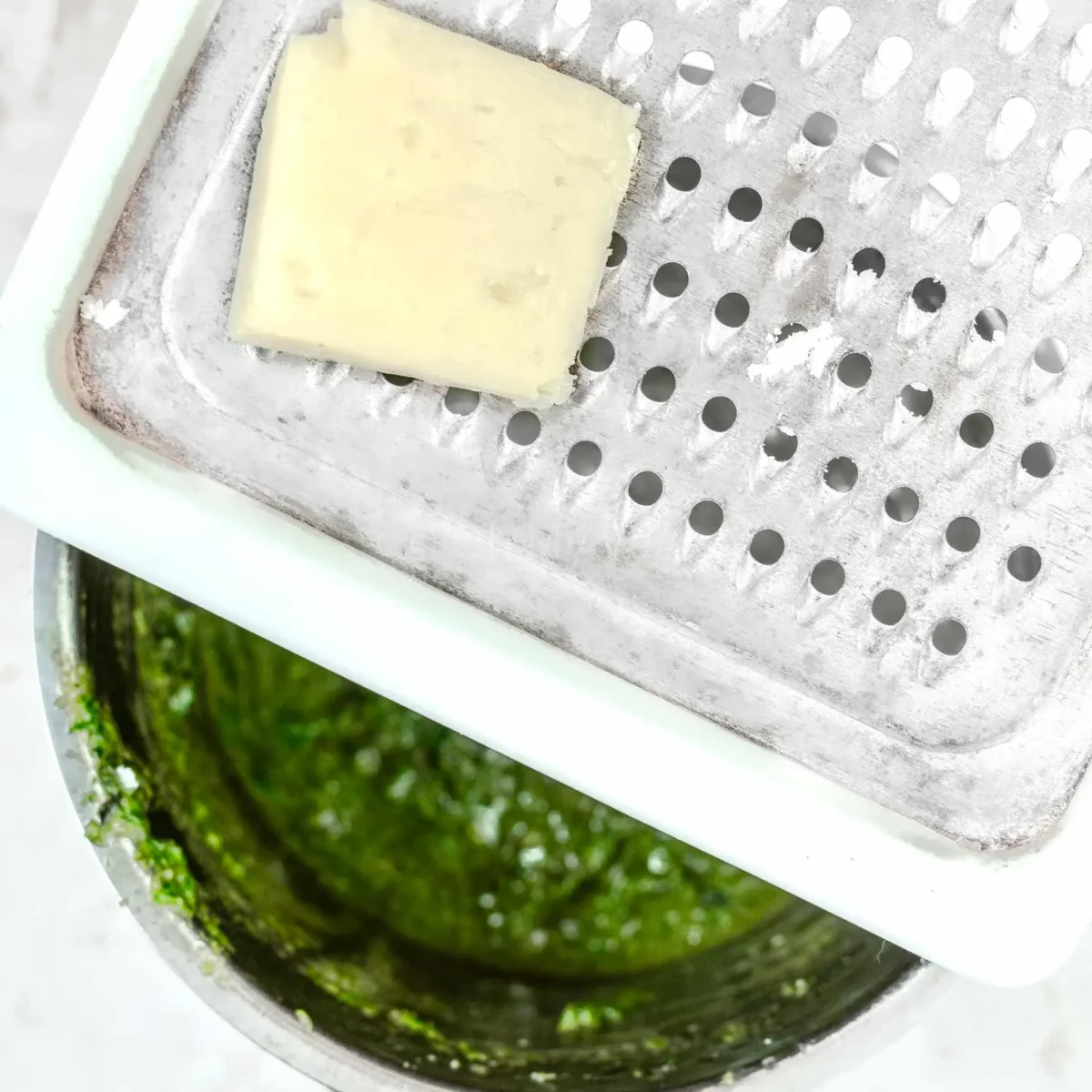
Seven: Using a small grater or microplane, grate pecorino cheese into the pesto.

Eight: Stir the cheese through. Taste and check for seasoning, adjusting as needed.
As usual, the complete recipe (with ingredient quantities and instructions) can be found at the bottom of this page. You can also print the recipe, save the recipe, adjust the servings, and much more from there!
⭐Top Tips for Success
I may not be Italian, but I have made countless jars of pesto — here’s what I’ve learnt along the way.
- Quality of ingredients is key. Use fresh, vibrant basil (no wilted, bruised, or browning leaves). Use pure, cold-pressed olive oil. Don’t even think about using vegetable oil or canola oil; your pesto will be severely flavour deficient.
- Don’t over-blend! Great basil pesto is creamy and well emulsified, but not smooth. Even when you’re using time-saving measures like a food processor or blender, don’t rush the process.
- Go easy on the garlic. When people complain about pesto being too pungent, it’s usually the garlic that’s at fault. I love garlic (I mean, I’m the kind of person that puts a head of garlic in a recipe instead of a few cloves!), but restraint is crucial. Raw garlic doesn’t have the buttery notes of cooked alliums, instead leaning more spicy. Use a small clove, and opt for a sweeter, milder variety with less bite, like softneck garlic.
Finally, trust your palate and taste as you go. This recipe is a guide (a pretty good one, I hope!), but ingredients vary significantly. If your garlic is sharper, use less. If you’re not using cheese, use more salt.
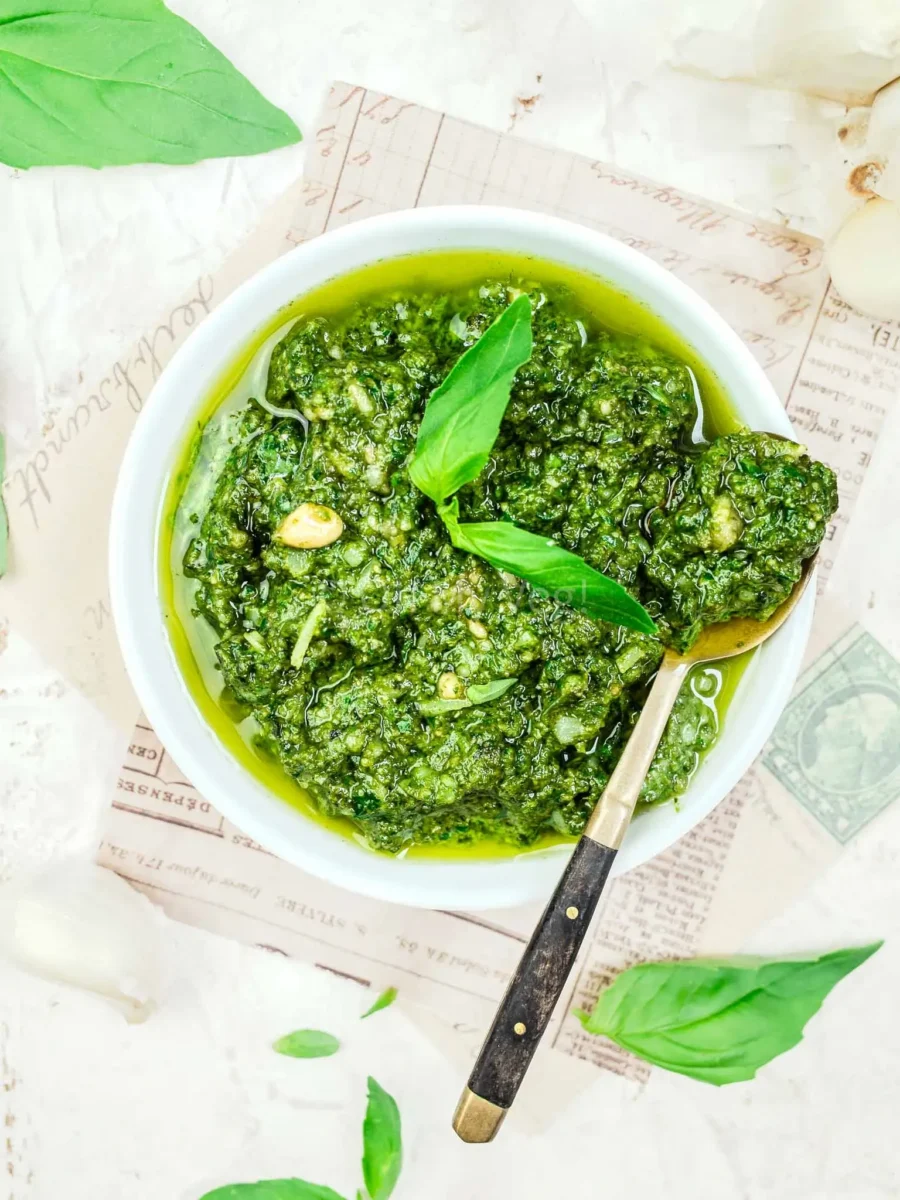
🫙Storage
Pesto basilico stores exceptionally well.
Simply keep it in a small, clean jar. Pour extra olive oil on top to form a barrier. This will stop the pesto from browning. Homemade pesto has a wonderfully vibrant green colour, and it would be a shame to ruin that.
Stored in a closed jar, basil pesto will keep for five days in the fridge.
You can also freeze pesto for easy instant access.
Rather than freezing a whole jar, I always freeze condiments like green chutney, sundried tomato dressing, and basil pesto in ice cube trays. The trays make for perfectly-portioned pieces that are easy to grab-and-go. Frozen, pesto will last around two months.
🥪How to Use Pesto al Basilico in Your Cooking
Pesto doesn’t need to be cooked. In fact, cooking ruins all those fresh, bright, and bold flavours. But this isn’t a limitation — there are countless ways you can use pesto to elevate your meals. Here’s a few ideas:
- Toss with pasta: Perhaps the most classic and certainly the most obvious use for basil pesto, but that doesn’t make the combination any less delicious. Boil your favourite pasta, toss with a spoonful or two of pesto, a ladle of pasta water (to loosen), then top with freshly grated cheese. It’s easy, oh-so-quick, and a real crowd-pleaser. Try my spaghetti al pesto or pesto rigatoni.
- Use as a dip: Keep the pesto as-is for a scrumptious bread dipping oil that’ll have you coming back for more. It’s also great for dipping arancini and pizza crusts! Alternatively, mix in sour cream, mayonnaise, or yoghurt to create a thick dip for crisps (chips in the U.S.) or crackers.
- Spread it: Slather the pesto on sandwiches, flatbreads, wraps, or pizza dough. A small portion of pesto packs a punch, making it ideal for upgrading bread! My current obsession? Pesto caprese sandwiches with tomato and mozzarella.
- Dollop onto soups: A spoonful on top of tomato soup instantly brightens the dish.
- Drizzle over salad: Pesto pairs with so many salads. Caprese salad, arugula and spinach salad, Italian chopped salad … there’s endless choices!
- Use as a stuffing: Just like people use pesto to stuff chicken breasts, you can do the same with tofu or seitan. Or, if you think outside the box, you can use this pesto al basilico to stuff arancini balls, dough balls, or stuffed mushrooms.
Now you’re armed with all that drool-inducing inspiration, what will you cook first? Let me know how you plan to use your pesto di basilico in the comments below — I’m sure my other readers would love to know, too!
If you tried this pesto di basilico recipe — or any other recipe on my website — please leave a 🌟 star rating and let me know your thoughts in the ✍️ comments at the bottom of the page. Thanks for being a part of my community!
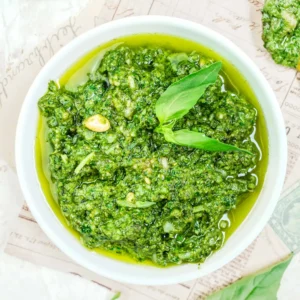
Pesto di Basilico Recipe
Ingredients
- 20 g pine nuts
- 1 clove garlic
- 30 g basil
- 3 tablespoons olive oil 3 tablespoons = 40g
- salt to taste
- 10 g vegetarian italian hard cheese
Instructions
- Add 20 g pine nuts and 1 clove garlic to a food processor. Pulse quickly until the mixture becomes a coarse paste (not smooth).
- Add 30 g basil and pulse again, until the basil is chopped into ultra-fine pieces.
- Pour in 3 tablespoons olive oil and salt (to taste; note that cheese is salty). Stir through the mixture until it becomes creamy.
- Use a fine grater or microplane to grate 10 g vegetarian italian hard cheese (I use vegetarian pecorino) into the pesto di basilico. Stir through.


